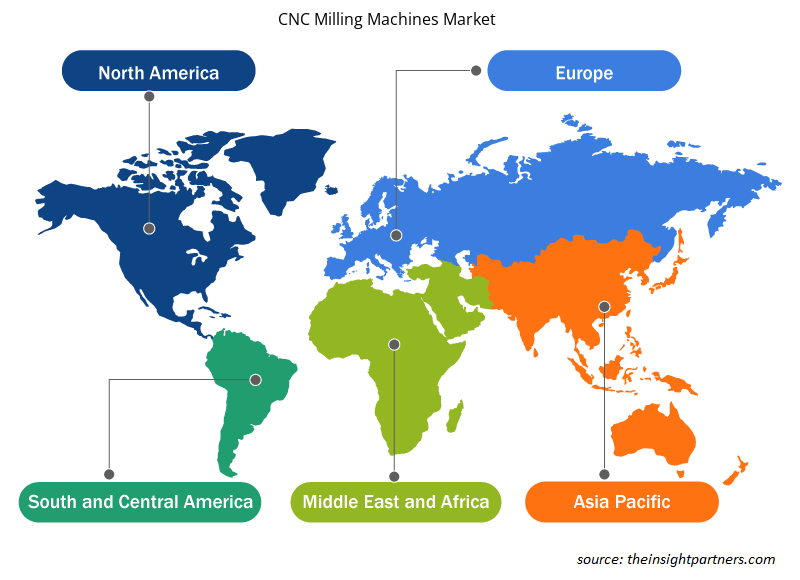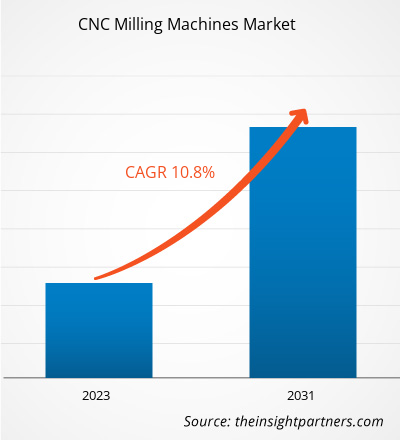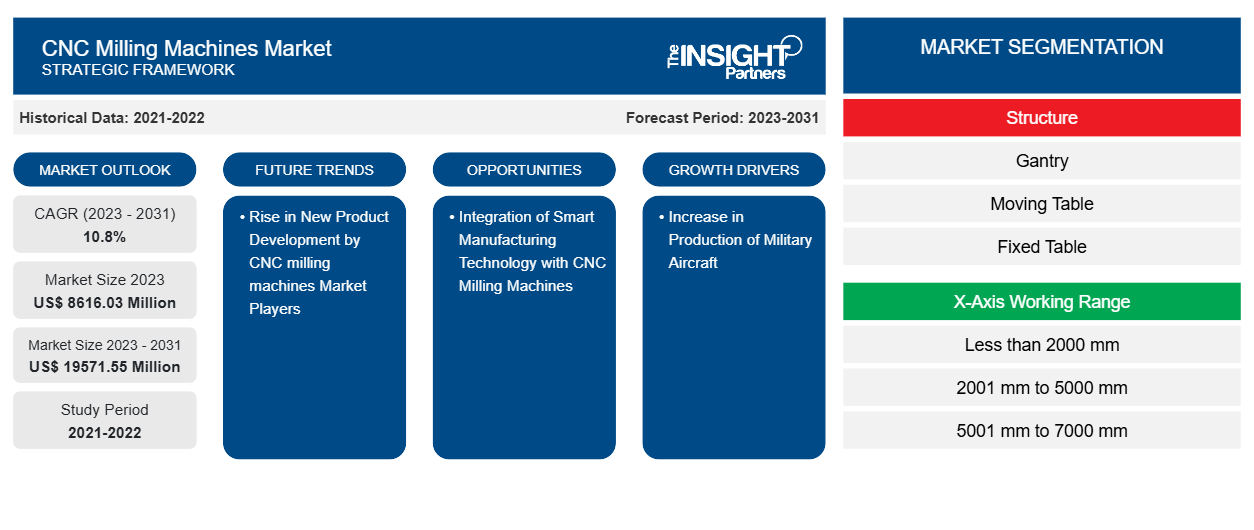预计到 2031 年,数控铣床 市场规模将从 2023 年的 86.1603 亿美元增至 195.7155 亿美元。预计 2023-2031 年市场复合年增长率为 10.8%。全球对电动汽车的需求不断增长,有力地推动了汽车行业的发展。全球汽车行业正在经历重大变化,例如电动汽车和自动驾驶汽车产量的增加。许多汽车制造商通过在全球范围内采用自动化和扩建生产工厂来提高产量。根据国际能源署 (IEA )的数据,尽管存在供应链瓶颈和 COVID-19 疫情,但 2021 年的电动汽车 ( EV ) 销量与 2020 年相比几乎翻了一番。2021 年售出了近 660 万辆电动汽车,全球共有 1650 万辆电动汽车上路。 2021 年,中国售出330 万辆电动汽车,而 2020 年为 120 万辆。汽车行业是CNC铣床的最大用户之一。在汽车行业,CNC铣床制造内饰板、牵引电机和各种定制零件。CNC加工还帮助汽车行业开发功能原型,这些原型可以在测试和验证后投入批量生产。因此,汽车行业的增长主要推动着CNC铣床市场的发展。
数控铣床市场分析
全球汽车行业正在经历重大变化,例如电动汽车和自动驾驶汽车产量的上升。许多汽车制造商通过在全球范围内采用自动化和扩建生产工厂来提高产量。下面列出了近年来开设的一些新制造工厂:
- 2021年9月,福特宣布在美国开设新的电动汽车制造厂,投资额为114亿美元。
- 2022年9月,大陆集团在德克萨斯州开设了新的汽车生产工厂,投资额为1.1亿美元。
- 2021年10月,日产宣布在栃木县开设新生产工厂 ,该工厂致力于生产实现碳中和的下一代汽车。
全球各地新工厂的开业促进了汽车产量的增长。2022 年与 2021 年相比,一些国家的汽车产量增长情况如下:
|
国家
|
2021
|
2022
|
% 改变
|
|
美国
|
9,167,214 |
10,060,339 |
10% |
|
德国
|
3,308,692 |
3,677,820 |
11% |
|
中国
|
26,082,220 |
27,020,615 |
3% |
|
印度
|
4,399,112 |
5,456,857 |
24% |
|
印度尼西亚
|
1,121,967 |
1,470,146 |
31% |
|
南非
|
499,087 |
555,889 |
11% |
|
阿根廷
|
434,753 |
536,893 |
24% |
来源:国际汽车制造商组织
CNC 铣床广泛应用于汽车生产,包括制造内饰板、变速箱、定制零件和发动机等多个部件。因此,全球汽车产量的增长推动了对 CNC 铣床的需求,从而促进了 CNC 铣床市场的增长。
数控铣床市场概况
计算机数控 (CNC) 铣床是减材制造最重要的机器,它从工件上去除材料以制造成品。这与 3D 打印、铸造或注塑等增材制造工艺不同,在这些工艺中,通过添加材料来制造成品。该工艺从要生产零件的二维或三维计算机辅助设计 (CAD) 表示开始。CAD 指导工件的切割过程,并精确定义零件的尺寸和要求。CNC 铣削是 1952 年使用的第一种 CNC 工艺,可以重塑各种材料,例如金属、玻璃、合金、塑料或木材。它是最常见的 CNC 工艺,可以编程为生产符合精确规格的定制零件。目前,许多市场参与者提供具有各种规格、尺寸和功能的广泛产品。
定制此报告以满足您的需求
您可以免费定制任何报告,包括本报告的部分内容、国家级分析、Excel 数据包,以及为初创企业和大学提供优惠和折扣
-
获取此报告的关键市场趋势。这个免费样品将包括数据分析,从市场趋势到估计和预测。
数控铣床市场区域洞察
Insight Partners 的分析师已详尽解释了预测期内影响 CNC 铣床市场的区域趋势和因素。本节还讨论了北美、欧洲、亚太地区、中东和非洲以及南美和中美洲的 CNC 铣床市场细分和地理位置。

- 获取数控铣床市场的区域特定数据
数控铣床市场报告范围
| 报告属性 | 细节 |
|---|---|
| 2023 年的市场规模 | 86.1603 亿美元 |
| 2031 年市场规模 | 195.7155 亿美元 |
| 全球复合年增长率(2023 - 2031) | 10.8% |
| 史料 | 2021-2022 |
| 预测期 | 2023-2031 |
| 涵盖的领域 |
按结构
|
| 覆盖地区和国家 |
北美
|
| 市场领导者和主要公司简介 |
|
市场参与者密度:了解其对商业动态的影响
CNC 铣床市场正在快速增长,这得益于终端用户需求的不断增长,而这些需求又源于消费者偏好的不断变化、技术进步以及对产品优势的认识不断提高等因素。随着需求的增加,企业正在扩大其产品范围,进行创新以满足消费者的需求,并利用新兴趋势,从而进一步推动市场增长。
市场参与者密度是指在特定市场或行业内运营的企业或公司的分布情况。它表明在给定市场空间中,相对于其规模或总市场价值,有多少竞争对手(市场参与者)存在。
在 CNC 铣床市场运营的主要公司有:
- 大隈株式会社
- 日本电产株式会社
- 尼古拉斯·科雷亚
- 南非
- 亚崴機電股份有限公司
- EMCO 有限公司
免责声明:上面列出的公司没有按照任何特定顺序排列。

- 获取 CNC 铣床市场顶级关键参与者概述
CNC 铣床市场新闻和最新发展
通过收集一手和二手研究后的定性和定量数据来评估 CNC 铣床市场,其中包括重要的公司出版物、协会数据和数据库。以下是市场创新、业务扩展和战略发展情况的列表:
- 2023 年 1 月,EMCO 和 GLM 成立了 EMCO GLM GMBH。在非常成功的筹备阶段之后,两家公司在销售、应用技术、自动化和服务领域的合作已经取得了良好的开端,新公司 EMCO GLM GmbH 的成立开始了,该公司拥有 EMCO 的多数股权。(来源:EMCO,新闻稿)
- 2022 年 12 月,TRIMILL 成功向德国客户交付了一台 5 轴 TRIMILL VFC 3021 铣床。该铣床配备 2 轴叉式铣头 T21C,专为连续铣削而设计,具有高精度和高刚性。TRIMILL 声称为客户提供高质量和定制的铣削解决方案,以及在全球范围内成功交付和安装机器的能力。(来源:TRIMILL,新闻稿)
数控铣床市场报告覆盖范围和交付成果
“数控铣床市场规模和预测(2021-2031 年)”报告对市场进行了详细分析,涵盖以下领域:
- 范围内涵盖的所有主要细分市场的全球、区域和国家层面的 CNC 铣床市场规模和预测。
- 市场动态,如驱动因素、限制因素和关键机遇
- 数控铣床市场趋势
- 详细的 PEST/波特五力分析和 SWOT 分析
- CNC 铣床市场分析涵盖主要市场趋势、全球和区域框架、主要参与者、法规和最新市场发展
- 数控铣床市场格局和竞争分析,包括市场集中度、热图分析、知名参与者和最新发展。
- 详细的公司简介
- 历史分析(2 年)、基准年、预测(7 年)及复合年增长率
- PEST和SWOT分析
- 市场规模、价值/数量 - 全球、区域、国家
- 行业和竞争格局
- Excel 数据集
近期报告
客户评价
购买理由
- 明智的决策
- 了解市场动态
- 竞争分析
- 客户洞察
- 市场预测
- 风险规避
- 战略规划
- 投资论证
- 识别新兴市场
- 优化营销策略
- 提升运营效率
- 顺应监管趋势























 获取免费样品 - 数控铣床市场
获取免费样品 - 数控铣床市场